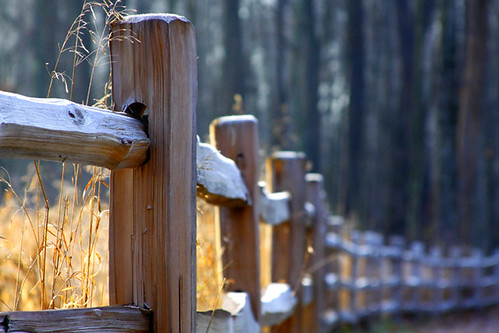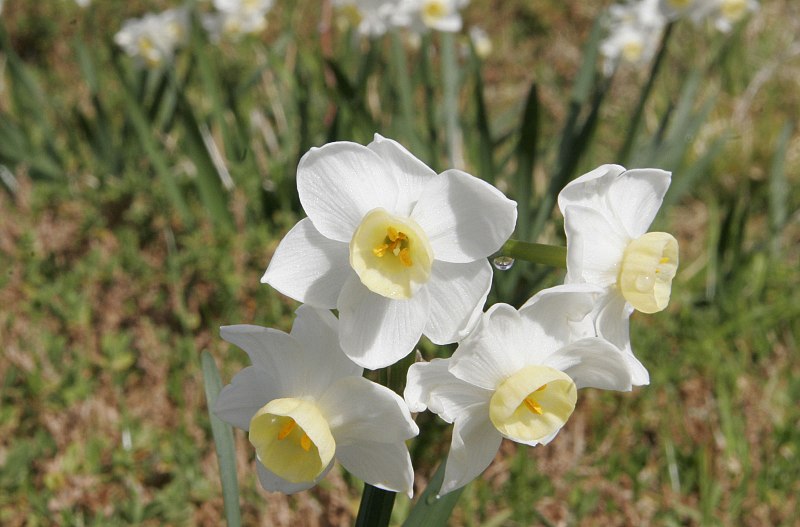Part 1
Aperture & F-Stop
The aperture is the size of the opening in your lens. Imagine it as your eye's iris. In a dark environment, your iris will enlarge allowing more light into your eye, but in a brightly lit place, your iris will shrink. Basically, the aperture controls the amount of light that enters your camera. A bigger aperture means more light can enter, and a small aperture allows less light in.
A few notes about big apertures:
- Great for low-light conditions and very versatile.
- Because of the above mentioned point, lenses with large apertures are generally more sought after by photographers and are typically the most expensive lenses available.
- Lenses with very large apertures are generally Prime lenses, which are lenses with a fixed focal length - cannot be zoomed. Ex. Canon EF 50mm f/1.2L
- If your lens has a large maximum aperture, it does not mean that you need to always use it at its largest aperture. You have full control of the camera. This will be explained later. Taking a picture with the lens at its maximum aperture is called shooting Wide Open.
The number that indicates how big or small the aperture is on your lens is called the F-Stop number. Remember this important point: F-stop numbers and the size of the aperture are inversely related meaning the smaller the F-stop the bigger the aperture. Increasing the F-stop decreases the size of the aperture and vice versa. Put your camera in Aperture Priority (AV) mode. You will see the F-stop number somewhere and it'll look something like F/3.5. I would consider a lens with a large aperture that's ideal for low-light conditions something with an F-stop at or lower than f/2.8. A steady hand and tripod can compensate for most slow lens.
Very important points to take from what you've read:
- Bigger Aperture = Faster Shutter Speed
- Small Aperture = Slower Shutter Speed
What about in brightly lit places? Why is controlling the aperture useful in this situation? This will be explained in the Depth of Field explanation.
Part 2
Depth of Field
Now to put everything together. We know that the aperture is the size of the lens opening; changing the aperture changes the amount of light that can enter the camera which affects how fast or slow your camera is; and finally the aperture can be controlled by adjusting the F-Stop number on your camera.
These settings and functions are important for the Depth of Field (DOF) in your picture. Depth of Field controls the visual contrast between the subject and the background/foreground. There are two important terms here: Small/Shallow DOF and Large/Deep DOF. I will be using Shallow & Deep DOF in my explanations. Confused? Keep reading.
Remember: Large Aperture = Shallow DOF. Small Aperture = Deep DOF. Do you remember what the F-Stop Number rule should be in both situations?
Simply put, if you want to isolate your subject from its surrounding, you will want a Shallow DOF. Your camera will mainly focus on your subject and blur the background or foreground. The blur is called Bokeh.
If you want more of your background or foreground in focus/clearer and less blurry, you will want a Deep DOF. Aperture is extremely important here so remember its relationship with DOF.
In the next two pictures, try to guess:
1) What type of DOF.
2) Guesstimate the size of the Aperture & F-Stop number.
3) For the aperture you guessed, what happens to the speed of your shutter? Fast or Slow?
Photo #1
Photo #2
Photo #1You see how the closest flower is in focus and the background is blurry, so to answer the above the questions - A Shallow DOF was used; A large aperture was used meaning a low F-Stop number; and a fast shutter. There's a lot of Bokeh here. The picture was shot at F/5. Can you imagine if it were shot at f/1.2?
Photo #2
The background is much more in focus compared to that in the first picture so you can assume that: A Deep DOF was used; A small aperture was used meaning a large F-Stop number; and a slow shutter. The picture was shot at f/32.
Pictures with Shallow DOF can give you some cool shots that isolate your subject and directs the viewer's eyes to a certain object.
Those with Deep DOF are useful when you want most of your subject in focus ex. a static subject like a mountain or bridge or when there's no specific subject in the picture that you want to isolate. Remember that if you want a Deep DOF and the lighting is not good; your camera will be slower so you'll have to steady it on a tripod or on something that's not moving.
Important!
Because the shots above were shot in very well lit conditions and there was an abundance of light, the shutter speed for both were still pretty fast, albeit different. So if you're taking pictures during the daytime when there's a lot of light and you're not isolating anything in particular and want more things to be in focus, feel free to increase the aperture.
BUT (more advanced reading), if you do this it does not necessarily mean your pictures will be sharper. Each lens has a specific aperture where its the sharpest. If you increase the aperture too much, the sharpness of your pictures will likely degrade. If you sharpen a pencil too much the lead might chip or even break off.
Remember that increasing the aperture makes the shutter speed slower. Even if you have a tripod to help you with keeping your camera steady, you don't always need to increase the aperture to a ridiculously high level to focus your subject. Each camera and lens setup is unique and you'll have to find which settings provide optimal sharpness.
Do you understand everything so far? If you are, then you can read the notes below.
- Have an interesting background or foreground to contrast against your focused subject. Imagine you're at a hockey game and you want to take a picture of your ticket. What kind of background do you want in your picture? The floor or the rink? Of course the rink so you'll have to hold the ticket up and focus it while blurring the background of the rink. Basically try to avoid shooting something from above unless there's something interesting on the ground.
- When you have a specific thing you want to focus and get the viewer's attention, try to get close to the subject either by zooming or walking to it. This will eliminate distracting surroundings.
- Ex. Imagine you're taking picture of a fence. You want to create a Shallow DOF. What would you do to accomplish this and create something like the picture below?
 From the picture above, the shooter focused and got close to the left post either by zooming or walking; then framed the picture from eye-level and avoided shooting from above. An aperture of f/5.6 was used (I found out through the author). If the aperture was bigger, the other posts would be blurrier creating a shallower DOF and more Bokeh
From the picture above, the shooter focused and got close to the left post either by zooming or walking; then framed the picture from eye-level and avoided shooting from above. An aperture of f/5.6 was used (I found out through the author). If the aperture was bigger, the other posts would be blurrier creating a shallower DOF and more BokehPart 3
Brief explanation of the numbers and letters on your lens
Use the below picture as a reference.
- 58mm = diameter of the lens filter
- EF-S - Type of mount between the lens and camera body. There are two types of mounts: EF-S & EF. EF-S mounts are mainly for Crop Cameras and EF Mounts are mainly for Full Frame lenses. You can read here for a longer explanation. EF Lenses can be used on newer Crop & Full-Frame bodies, while EF-S Lenses can only be used on Crop Bodies. The difference between Crop & Full Frame bodies is pretty simple. Crop bodies have smaller sensors while Full Frames have larger ones. So if you take a picture from a single position using both bodies, a picture from the Crop body will look like it's zoomed in. The article above has some good pictures.
- 18-55mm = Minimum & Maximum focal length of your zoom lens. This is a standard range for kit lenses. Remember that prime lenses have fixed focal lengths.
- 1:3.5-5.6 = Maximum aperture for your focal length. So at 18mm, the max aperture is f/3.5 and at 55mm it's f/5.6. If you start at 18mm and then zoom to 55mm, the camera will change the aperture. You can see a visual of the aperture changing its size on new Nikon DSLRs. Many lenses have fixed apertures meaning that even if you zoom, the aperture can always stay the same. These lenses are typically more expensive if it provides a large maximum aperture.
- IS = Image Stabilization. The lens compensates for some camera shake NOT the movement of your subject. Also called VR on Nikon cameras.
Exercise #1
Similar to the example above of the two pictures of the same flower, I want you to tell me:
1) What DOF is used.
3) What part of the picture is in focus.
2) Guess the size of the Aperture & F-Stop number (Nothing bigger than f/2.8) and if possible tell me Why were these settings used.
3) For the aperture you guessed, what happens to the speed of your shutter? Fast or Slow?
#1

Exercise #2
Take pictures of the following:
1) Two pictures of the same subject at the same shooting position with one having a shallow DOF and the other with a deep DOF. A tripod will be useful here. Explain what settings were used and why. I want something with a nice background - nothing shot from above.
2) One picture showing a strong Shallow DOF that attracts the viewers attention on a specific part of the photo. Explain what settings were used.
Exercise #3
Answer the following questions.
1) If I'm outside and the sun has set and it's dark, what settings should I use on my camera?
2) My camera is set at f/20. Is the size of the lens' aperture big or small? What about the sharpness of the image?
3) It's during the day and I want to take a picture with most of what's in view to be in focus. What settings should I use?
4) I'm taking a close up picture of something and I want to isolate the subject from its surroundings and create a shallow DOF. What settings should I use? How should I focus the subject?
5) Can EF-S lenses be used on crop bodies?
6) What's the other name for background blur?
7) If it's dark outside and I want to use use a high F-Stop, how should I accomplish this?
Have fun!









